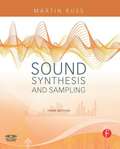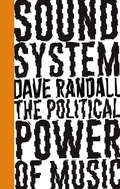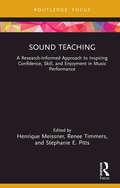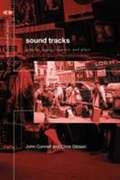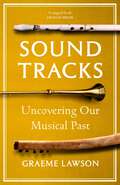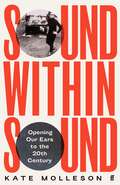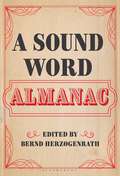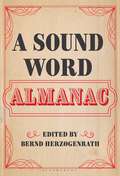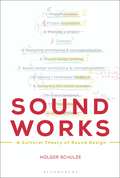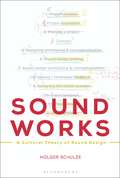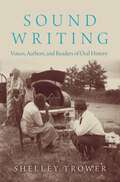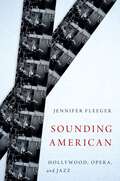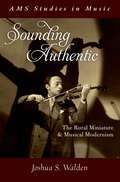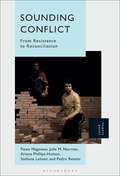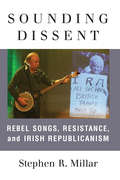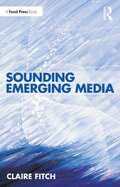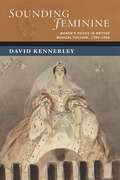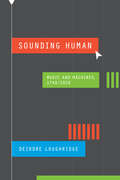- Table View
- List View
Sound Synthesis And Sampling
by Martin RussSound Synthesis and Sampling' provides a comprehensive introduction to the underlying principles and practical techniques applied to both commercial and research sound synthesizers. This new edition has been updated throughout to reflect current needs and practices- revised and placed in a modern context, providing a guide to the theory of sound and sampling in the context of software and hardware that enables sound making. For the revised edition emphasis is on expanding explanations of software and computers, new sections include techniques for making sound physically, sections within analog and digital electronics. Martin Russ is well known and the book praised for its highly readable and non-mathematical approach making the subject accessible to readers starting out on computer music courses or those working in a studio.
Sound System: The Political Power of Music (Left Book Club)
by Dave RandallMusicians have often wanted to change the world. From underground innovators to pop icons many have believed in the political power of music. Rulers recognise it too. Music has been used to challenge the political and social order - and to prop up the status quo.*BR**BR*Sound System is the story of one musician's journey to discover what makes music so powerful. Dave Randall uses his insider's knowledge of the industry to shed light on the secrets of celebrity, commodification and culture.*BR**BR*This is a book of raves, riots and revolution. From the Glastonbury Festival to the Arab Spring, Pop Idol to Trinidadian Carnival, Randall finds political inspiration across the musical spectrum and poses the question: how can we make music serve the interests of the many, rather than the few? *BR**BR*Published in partnership with the Left Book Club.
Sound System: The Political Power of Music (Left Book Club)
by Dave RandallMusicians have often wanted to change the world. From underground innovators to pop icons many have believed in the political power of music. Rulers recognise it too. Music has been used to challenge the political and social order - and to prop up the status quo.*BR**BR*Sound System is the story of one musician's journey to discover what makes music so powerful. Dave Randall uses his insider's knowledge of the industry to shed light on the secrets of celebrity, commodification and culture.*BR**BR*This is a book of raves, riots and revolution. From the Glastonbury Festival to the Arab Spring, Pop Idol to Trinidadian Carnival, Randall finds political inspiration across the musical spectrum and poses the question: how can we make music serve the interests of the many, rather than the few? *BR**BR*Published in partnership with the Left Book Club.
Sound Teaching: A Research-Informed Approach to Inspiring Confidence, Skill, and Enjoyment in Music Performance
by Henrique Meissner Renee Timmers Stephanie E. PittsSound Teaching explores the ways in which music psychology and education can meet to inspire developments in the teaching and learning of music performance. The book is based on music practitioners’ research into aspects of their own professional practice. Each chapter addresses a specific topic related to musical communication and expression, performance confidence and enjoyment, or skill development in individual and group learning. It explains the background of the research, outlines main findings, and provides suggestions for practical applications. Sound Teaching provides a research-informed approach to teaching and contributes to music tutors’ professional development in teaching children and adults of various ages and abilities. Sound Teaching is written for vocal and instrumental music teachers, music performers with a portfolio career, and music students at conservatoires and universities. Music students undertaking practice-related research will find examples of research methodologies and projects that are informative for their studies. Musical participants of all kinds – students, teachers, performers, and audiences – will find new ways of understanding their practice and experience through research.
Sound Teaching: A Research-Informed Approach to Inspiring Confidence, Skill, and Enjoyment in Music Performance
by Henrique Meissner Renee Timmers Stephanie E. PittsSound Teaching explores the ways in which music psychology and education can meet to inspire developments in the teaching and learning of music performance. The book is based on music practitioners’ research into aspects of their own professional practice. Each chapter addresses a specific topic related to musical communication and expression, performance confidence and enjoyment, or skill development in individual and group learning. It explains the background of the research, outlines main findings, and provides suggestions for practical applications. Sound Teaching provides a research-informed approach to teaching and contributes to music tutors’ professional development in teaching children and adults of various ages and abilities. Sound Teaching is written for vocal and instrumental music teachers, music performers with a portfolio career, and music students at conservatoires and universities. Music students undertaking practice-related research will find examples of research methodologies and projects that are informative for their studies. Musical participants of all kinds – students, teachers, performers, and audiences – will find new ways of understanding their practice and experience through research.
Sound Tracks: Popular Music Identity and Place (PDF)
by John ConnellSound Tracks is the first comprehensive book on the new geography of popular music, examining the complex links between places, music and cultural identities. It provides an interdisciplinary perspective on local, national and global scenes, from the 'Mersey' and 'Icelandic' sounds to 'world music', and explores the diverse meanings of music in a range of regional contexts.
Sound Tracks: Uncovering Our Musical Past
by Graeme LawsonA transporting voyage of archaeological discovery: Sound Tracks unearths instruments from around the world and across time, releasing the past's musical secrets for the first time. ‘A thrilling journey into the sonic richness of human experience’ PHILIP BALL, author of The Music Instinct‘A magical book’ FRANCIS PRYOR, author of Britain BCFrom the present day back to the dawn of time, from dark caves and murky swamps to open deserts and ocean depths, here is the history of humankind's relationship with music in fifty detective stories.We see a child’s delight in Peru in AD 700, playing with a water-filled pot that chirps like a bird; we shiver with a lonely soldier sending trumpet signals to the next watchtower on Hadrian's Wall; we sway to the stately rhythms of the 64 bells buried in a tomb in China in the 5th century BC. And on this grand tour, we learn that music is part of what makes us human – a way of commemorating our pasts, communicating with others and shaping our lives.Brimming with astonishing insights, Sound Tracks provides an enthralling alternative history of humanity in which the silences of the past are filled with a glorious treasure hoard of vanished sounds and voices.‘Piles revelation upon revelation to shed a completely new perspective on the tools we use for making music’ NORMAN LEBRECHT, author of Why Beethoven‘Lawson has brilliantly conjured up the sounds of 30,000 years of human history’ DAVID ABULAFIA, Professor Emeritus of Mediterranean History
Sound Within Sound: Opening Our Ears to the Twentieth Century
by Kate MollesonA radical new book by journalist, critic and BBC Radio 3 broadcaster Kate Molleson, which fundamentally changes the way we think about classical music and the musicians who made it on a global scale.'Wonderful . . . This is a book of discovery that speaks of music as a life force, that urges us to live our lives through music. 'COSEY FANNI TUTTI'A marvellous book that opens our ears to sonic worlds that will enrich and delight us, whoever and wherever we are.'IAN McMILLAN'A clear-eyed, utterly fascinating exploration of outsiders in classical music. Molleson's excellent book challenges and enlightens.'SINÉAD GLEESONThis is the impassioned and exhilarating story of the composers who dared to challenge the conventional world of classical music in the twentieth century.Traversing the globe from Ethiopia and the Philippines to Mexico, Jerusalem, Russia and beyond, journalist, critic and BBC Radio 3 broadcaster Kate Molleson tells the stories of ten figures who altered the course of musical history, only to be sidelined and denied recognition during an era that systemically favoured certain sounds - and people - over others.A celebration of radical creativity rooted in ideas of protest, gender, race, ecology and resistance, Sound Within Sound is an energetic reappraisal of twentieth-century classical music that opens up the world far beyond its established centres, challenges stereotypical portrayals of the genre and shatters its traditional canon.'Sound Within Sound is absolutely inspiring. Everyone who loves music should own this book.'CHARLOTTE HIGGINS'A necessary and deeply humane reshaping of music histories. It undoes the narrowing constraints of the classical canon, leaving the culture - and the reader - beautifully enriched.'EMMA WARREN'Marvellous . . . required reading.'THE WIRE
A Sound Word Almanac
by Bernd HerzogenrathThis almanac of sound words important to artists and scholars highlights words that expand the way we speak (and write) about sonic experiences.Why write about sound, and how? If sonic philosophy is the attempt "to think about sound by philosophical means," then a metaphilosophical debate appears almost immediately on the horizon: What is called for is an understanding about sound and language, but also about the preconditions of musical understanding. What is at stake is the question of language and sound, as well as expanding how we speak about sonic experience.This almanac tackles these questions from artistic, experimental and personal perspectives. An assemblage of nearly 70 practitioners and theoreticians, artists and scholars offer their favorite 'sound word.' These sound words are onomatopoetical, mythological, practical; words of personal importance to the artists and their craft; words from their memory, related to sound. Many entries are not in English – some are untranslatable – and all are accompanied by a personal, explanatory, poetic entry. These are words that have the potential to change our perspective on listening-musicking-thinking.
A Sound Word Almanac
This almanac of sound words important to artists and scholars highlights words that expand the way we speak (and write) about sonic experiences.Why write about sound, and how? If sonic philosophy is the attempt "to think about sound by philosophical means," then a metaphilosophical debate appears almost immediately on the horizon: What is called for is an understanding about sound and language, but also about the preconditions of musical understanding. What is at stake is the question of language and sound, as well as expanding how we speak about sonic experience.This almanac tackles these questions from artistic, experimental and personal perspectives. An assemblage of nearly 70 practitioners and theoreticians, artists and scholars offer their favorite 'sound word.' These sound words are onomatopoetical, mythological, practical; words of personal importance to the artists and their craft; words from their memory, related to sound. Many entries are not in English – some are untranslatable – and all are accompanied by a personal, explanatory, poetic entry. These are words that have the potential to change our perspective on listening-musicking-thinking.
Sound Works: A Cultural Theory of Sound Design
by Holger SchulzeWhat is sound design? What is its function in the early 21st century and into the future?Sound Works examines these questions in four parts: Part 1, "Why This Sound?", presents an overview of the modern history of sound design. Part 2 is highly visual and provides a glance onto a sound designer's workbench and the current state of "Sonic Labor." Part 3 uses cultural analysis to explore our contemporary "Living with Sounds." The final and fourth part then proposes a series of anthropological and political interpretations of how “Sound Works” today. This book is not a manual on sound design; it instead argues for a cultural theory of sound design for sound designers and sound artists, for clients who commission a sound design and for researchers in the fields of sound studies, design research, and cultural studies
Sound Works: A Cultural Theory of Sound Design
by Holger SchulzeWhat is sound design? What is its function in the early 21st century and into the future?Sound Works examines these questions in four parts: Part 1, "Why This Sound?", presents an overview of the modern history of sound design. Part 2 is highly visual and provides a glance onto a sound designer's workbench and the current state of "Sonic Labor." Part 3 uses cultural analysis to explore our contemporary "Living with Sounds." The final and fourth part then proposes a series of anthropological and political interpretations of how “Sound Works” today. This book is not a manual on sound design; it instead argues for a cultural theory of sound design for sound designers and sound artists, for clients who commission a sound design and for researchers in the fields of sound studies, design research, and cultural studies
Sound Writing: Voices, Authors, and Readers of Oral History (Oxford Oral History Series)
by Shelley TrowerThe concept that oral history can give voice to people or allow "hidden voices" to become part of history is one of its most celebrated achievements. However, the standard practice of transcribing or summarizing interviews has meant that oral historians have had to grapple with questions of how to translate the oral into written form. What is lost or gained during this process of mediation? These re-creations can be wonderful and illuminating works of scholarship and art, and this book explores a wide range of the different forms they have taken-from John and Alan Lomax's transcriptions of African American songs for the Federal Writers Project to Svetlana Alexievich's polyphonic novels. Such works can give their subjects the necessary latitude to convey their narratives on their own terms, but there is also, always, the danger that their voices will be distorted or lost during the process of mediation. Sound Writing offers a thorough review of the varying arguments about editing for transcription and publication and reflects on how digital technologies enable much wider access to "raw" oral data. It examines how oral histories are co-created by speakers, the authors who mediate them, and readers, and it brings into sharp focus questions about how memory takes on subjective, narrative form. Finally, it examines the interplay between written literature and sound recordings, or orality, using a diverse range of examples-from the work of William Wordsworth and George Ewart Evans to Studs Terkel, Alex Haley, Luisa Passerini, Amrit Wilson, and Stacy Zembrzycki. As an interdisciplinary study, Sound Writing takes a broad approach to the written word to encompass not only transcriptions and other texts derived from oral history interviews but also literary precursors such as epic poetry and folklore, along with various related textual forms such as biography, autobiography, and blogs. It argues that the recording of oral traditions in print by poets, folklorists, anthropologists, and postcolonial writers is comparable to practices of recording, transcribing, and publishing familiar to oral historians. Literary genres have long influenced oral history narratives, and, in turn, oral history has helped shape literary forms.
Sound Writing: Voices, Authors, and Readers of Oral History (Oxford Oral History Series)
by Shelley TrowerThe concept that oral history can give voice to people or allow "hidden voices" to become part of history is one of its most celebrated achievements. However, the standard practice of transcribing or summarizing interviews has meant that oral historians have had to grapple with questions of how to translate the oral into written form. What is lost or gained during this process of mediation? These re-creations can be wonderful and illuminating works of scholarship and art, and this book explores a wide range of the different forms they have taken-from John and Alan Lomax's transcriptions of African American songs for the Federal Writers Project to Svetlana Alexievich's polyphonic novels. Such works can give their subjects the necessary latitude to convey their narratives on their own terms, but there is also, always, the danger that their voices will be distorted or lost during the process of mediation. Sound Writing offers a thorough review of the varying arguments about editing for transcription and publication and reflects on how digital technologies enable much wider access to "raw" oral data. It examines how oral histories are co-created by speakers, the authors who mediate them, and readers, and it brings into sharp focus questions about how memory takes on subjective, narrative form. Finally, it examines the interplay between written literature and sound recordings, or orality, using a diverse range of examples-from the work of William Wordsworth and George Ewart Evans to Studs Terkel, Alex Haley, Luisa Passerini, Amrit Wilson, and Stacy Zembrzycki. As an interdisciplinary study, Sound Writing takes a broad approach to the written word to encompass not only transcriptions and other texts derived from oral history interviews but also literary precursors such as epic poetry and folklore, along with various related textual forms such as biography, autobiography, and blogs. It argues that the recording of oral traditions in print by poets, folklorists, anthropologists, and postcolonial writers is comparable to practices of recording, transcribing, and publishing familiar to oral historians. Literary genres have long influenced oral history narratives, and, in turn, oral history has helped shape literary forms.
Sounding American: Hollywood, Opera, and Jazz (Oxford Music / Media)
by Jennifer FleegerSounding American: Hollywood, Opera, and Jazz tells the story of the interaction between musical form, film technology, and ideas about race, ethnicity, and the nation during the American cinema's conversion to sound. Contrary to most accepted narratives about the conversion, which tend to explain the competition between the Hollywood studios' film sound technologies in qualitative and economic terms, this book argues that the battle between disc and film sound was waged primarily in an aesthetic realm. Opera and jazz in particular, though long neglected in studies of the film score, were extremely important in defining the scope of the American soundtrack, not only during the conversion, but also once sound had been standardized. Examining studio advertisements, screenplays, scores, and the films themselves, author Jennifer Fleeger concentrates on the interactions between musical form and film technology, arguing that each of the major studios appropriated opera and jazz in a unique way in order to construct its own version of an ideal American voice. Traditional histories of Hollywood film music have tended to concentrate on the unity of the score, a model that assumes a passive spectator. Sounding American claims that the classical Hollywood film is essentially an illustrated jazz-opera with a musical structure that encourages an active form of listening and viewing in order to make sense of what is ultimately a fragmentary text.
Sounding Authentic: The Rural Miniature and Musical Modernism (AMS Studies in Music)
by Joshua S. WaldenSounding Authentic considers the intersecting influences of nationalism, modernism, and technological innovation on representations of ethnic and national identities in twentieth-century art music. Author Joshua S. Walden discusses these forces through the prism of what he terms the "rural miniature": short violin and piano pieces based on folk song and dance styles. This genre, mostly inspired by the folk music of Hungary, the Jewish diaspora, and Spain, was featured frequently on recordings and performance programs in the early twentieth century. Furthermore, Sounding Authentic shows how the music of urban Romany ensembles developed into nineteenth-century repertoire of virtuosic works in the style hongrois before ultimately influencing composers of rural miniatures. Walden persuasively demonstrates how rural miniatures represented folk and rural cultures in a manner that was perceived as authentic, even while they involved significant modification of the original sources. He also links them to the impulse toward realism in developing technologies of photography, film, and sound recording. Sounding Authentic examines the complex ways the rural miniature was used by makers of nationalist agendas, who sought folkloric authenticity as a basis for the construction of ethnic and national identities. The book also considers the genre's reception in European diaspora communities in America where it evoked and transformed memories of life before immigration, and traces how many rural miniatures were assimilated to the styles of American popular song and swing. Scholars interested in musicology, ethnography, the history of violin performance, twentieth-century European art music, the culture of the Jewish Diaspora and more will find Sounding Authentic an essential addition to their library.
Sounding Conflict: From Resistance to Reconciliation
by Fiona Magowan Pedro Rebelo Stefanie Lehner Julie M. Norman Ariana Phillips-HuttonSound, music and storytelling are important tools of resistance, resilience and reconciliation in creative practice from protracted conflict to post-conflict contexts. When they are used in a socially engaged participatory capacity, they can create counter-narratives to conflict. Based on original research in three continents, this book advances an interdisciplinary, comparative approach to exploring the role of sonic and creative practices in addressing the effects of conflict. Each case study illustrates how participatory arts genres are variously employed by musicians, arts facilitators, theatre practitioners, community activists and other stakeholders as a means of 'strategic creativity' to transform trauma and promote empowerment. This research further highlights the complex dynamics of delivering and managing creativity among those who have experienced violence, as they seek opportunities to generate alternative arenas for engagement, healing and transformation.
Sounding Conflict: From Resistance to Reconciliation
by Fiona Magowan Pedro Rebelo Stefanie Lehner Julie M. Norman Ariana Phillips-HuttonSound, music and storytelling are important tools of resistance, resilience and reconciliation in creative practice from protracted conflict to post-conflict contexts. When they are used in a socially engaged participatory capacity, they can create counter-narratives to conflict. Based on original research in three continents, this book advances an interdisciplinary, comparative approach to exploring the role of sonic and creative practices in addressing the effects of conflict. Each case study illustrates how participatory arts genres are variously employed by musicians, arts facilitators, theatre practitioners, community activists and other stakeholders as a means of 'strategic creativity' to transform trauma and promote empowerment. This research further highlights the complex dynamics of delivering and managing creativity among those who have experienced violence, as they seek opportunities to generate alternative arenas for engagement, healing and transformation.
Sounding Dissent: Rebel Songs, Resistance, and Irish Republicanism (Music and Social Justice)
by Stephen MillarThe signing of the Good Friday Agreement on April 10, 1998, marked the beginning of a new era of peace and stability in Northern Ireland. As the public has overwhelmingly rejected a return to the violence of the Troubles (1968–1998), loyalist and republican groups have sought other outlets to continue their struggle. Music has long been used to celebrate cultural identity in the North of Ireland: from street parades to football chants, and from folk festivals to YouTube videos, music facilitates the continuation of pre-Agreement identity narratives in a “post-conflict” era. Sounding Dissent draws on original in-depth interviews with Irish republican musicians, contemporary audiences, and former paramilitaries, as well as diverse historical and archival material, including songbooks, prison records, and newspaper articles, to understand the history of political violence in Ireland. The book examines the hagiographic potential of rebel songs to memorialize a pantheon of republican martyrs, and demonstrates how musical performance and political song not only articulate experiences and memories of oppression and violence, but play a central role in the reproduction of conflict and exclusion in times of peace.
Sounding Emerging Media
by Claire FitchSounding Emerging Media details a practice-based approach to sonic art and electroacoustic composition, drawing on methodologies inspired by the production of electronic literature, and game development. Using the structural concepts identified by Gilles Deleuze and Félix Guattari, the book is based around ideas related to labels such as Assemblage, Strata, Smooth and Striated Space, Temporal Space and, The Fold. The processes employed to undertake this research involved the creation of original texts, the development of frameworks for improvisation, the use of recordings within the process and implementation of techniques drawn from the practices of electroacoustic composition, and the use of ideas borrowed from electronic literature, publishing and game development. The results have helped to shape a compositional style which draws on these processes individually or collectively, drawing on practice often seen in game development, visual scores and composition using techniques found in electroacoustic music. Providing a journey through the landscape of emerging digital media, Sounding Emerging Media envisages a world where the composer/user/listener all become part of a continuum of collective artistry. This book is the ideal guide to the history and creation of audio for innovative digital media formats and represents crucial reading for both students and practitioners, from aspiring composers to experienced professionals.
Sounding Emerging Media
by Claire FitchSounding Emerging Media details a practice-based approach to sonic art and electroacoustic composition, drawing on methodologies inspired by the production of electronic literature, and game development. Using the structural concepts identified by Gilles Deleuze and Félix Guattari, the book is based around ideas related to labels such as Assemblage, Strata, Smooth and Striated Space, Temporal Space and, The Fold. The processes employed to undertake this research involved the creation of original texts, the development of frameworks for improvisation, the use of recordings within the process and implementation of techniques drawn from the practices of electroacoustic composition, and the use of ideas borrowed from electronic literature, publishing and game development. The results have helped to shape a compositional style which draws on these processes individually or collectively, drawing on practice often seen in game development, visual scores and composition using techniques found in electroacoustic music. Providing a journey through the landscape of emerging digital media, Sounding Emerging Media envisages a world where the composer/user/listener all become part of a continuum of collective artistry. This book is the ideal guide to the history and creation of audio for innovative digital media formats and represents crucial reading for both students and practitioners, from aspiring composers to experienced professionals.
Sounding Feminine: Women's Voices in British Musical Culture, 1780-1850 (New Cultural History of Music)
by David KennerleyBetween 1780 and 1850, the growing prominence of female singers in Britain's professional and amateur spheres opened a fraught discourse about women's engagement with musical culture. Protestant evangelical gender ideology framed the powerful, well-trained, and expressive female voice as a sign of inner moral corruption, while more restrained and delicate vocal styles were seen as indicative of the performer's virtuous femininity. Yet far from everyone was of this persuasion, and those from alternative class and religious milieux responded in more affirmative ways to the sound of professional female voices. The meanings listeners ascribed to women's voices reflect crucial developments in the musical world of the period, such as the popularity of particular genres with audiences of certain social backgrounds, and the reasons underpinning the development of prevalent types of nineteenth-century professional female vocality. Sounding Feminine traces the development of attitudes towards the female voice that have decisively shaped modern British society and culture. Arguing for the importance of the aural dimension of the past, author David Kennerley draws from a variety of fields-including sound studies, sensory histories, and gender theory-to examine how audiences heard different kinds of femininities in the voices of British female singers. Sounding Feminine explores the intense divisions over the "correct" use of the female voice, and the intricate links between gender, nationality, class, and religion in ascribing status, purpose, and morality to female singing. Through this lens, Kennerley also explores the formation of British middle-class identities and the cultural impact of the evangelical revival-deepening our understanding of this period of transformational change in British culture.
Sounding Feminine: Women's Voices in British Musical Culture, 1780-1850 (New Cultural History of Music)
by David KennerleyBetween 1780 and 1850, the growing prominence of female singers in Britain's professional and amateur spheres opened a fraught discourse about women's engagement with musical culture. Protestant evangelical gender ideology framed the powerful, well-trained, and expressive female voice as a sign of inner moral corruption, while more restrained and delicate vocal styles were seen as indicative of the performer's virtuous femininity. Yet far from everyone was of this persuasion, and those from alternative class and religious milieux responded in more affirmative ways to the sound of professional female voices. The meanings listeners ascribed to women's voices reflect crucial developments in the musical world of the period, such as the popularity of particular genres with audiences of certain social backgrounds, and the reasons underpinning the development of prevalent types of nineteenth-century professional female vocality. Sounding Feminine traces the development of attitudes towards the female voice that have decisively shaped modern British society and culture. Arguing for the importance of the aural dimension of the past, author David Kennerley draws from a variety of fields-including sound studies, sensory histories, and gender theory-to examine how audiences heard different kinds of femininities in the voices of British female singers. Sounding Feminine explores the intense divisions over the "correct" use of the female voice, and the intricate links between gender, nationality, class, and religion in ascribing status, purpose, and morality to female singing. Through this lens, Kennerley also explores the formation of British middle-class identities and the cultural impact of the evangelical revival-deepening our understanding of this period of transformational change in British culture.
Sounding Human: Music and Machines, 1740/2020 (New Material Histories of Music)
by Deirdre LoughridgeAn expansive analysis of the relationship between human and machine in music. From the mid-eighteenth century on, there was a logic at work in musical discourse and practice: human or machine. That discourse defined a boundary of absolute difference between human and machine, with a recurrent practice of parsing “human” musicality from its “merely mechanical” simulations. In Sounding Human, Deirdre Loughridge tests and traverses these boundaries, unmaking the “human or machine” logic and seeking out others, better characterized by conjunctions such as and or with. Sounding Human enters the debate on posthumanism and human-machine relationships in music, exploring how categories of human and machine have been continually renegotiated over the centuries. Loughridge expertly traces this debate from the 1737 invention of what became the first musical android to the creation of a “sound wave instrument” by a British electronic music composer in the 1960s, and the chopped and pitched vocals produced by sampling singers’ voices in modern pop music. From music-generating computer programs to older musical instruments and music notation, Sounding Human shows how machines have always actively shaped the act of music composition. In doing so, Loughridge reveals how musical artifacts have been—or can be—used to help explain and contest what it is to be human.
Sounding Human: Music and Machines, 1740/2020 (New Material Histories of Music)
by Deirdre LoughridgeAn expansive analysis of the relationship between human and machine in music. From the mid-eighteenth century on, there was a logic at work in musical discourse and practice: human or machine. That discourse defined a boundary of absolute difference between human and machine, with a recurrent practice of parsing “human” musicality from its “merely mechanical” simulations. In Sounding Human, Deirdre Loughridge tests and traverses these boundaries, unmaking the “human or machine” logic and seeking out others, better characterized by conjunctions such as and or with. Sounding Human enters the debate on posthumanism and human-machine relationships in music, exploring how categories of human and machine have been continually renegotiated over the centuries. Loughridge expertly traces this debate from the 1737 invention of what became the first musical android to the creation of a “sound wave instrument” by a British electronic music composer in the 1960s, and the chopped and pitched vocals produced by sampling singers’ voices in modern pop music. From music-generating computer programs to older musical instruments and music notation, Sounding Human shows how machines have always actively shaped the act of music composition. In doing so, Loughridge reveals how musical artifacts have been—or can be—used to help explain and contest what it is to be human.
